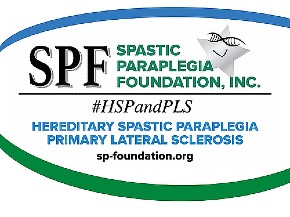Q&A with Allen Bernard & Dr. Craig Blackstone, M.D. , Ph.D about HSP in March 2018
Q&A with Dr. Craig Blackstone, M.D., Ph.D., a Senior Investigator at the National Institute of Neurological Disorders and Stroke at the National Institutes of Health in Washington, D.C.
Dr. Blackstone is a leading HSP researcher whose laboratory investigates the cellular and molecular mechanisms underlying hereditary movement disorders.
This interview was conducted in March of 2018.
Dr. Craig Blackstone has been working for years to unravel the mysteries of HSP with the goal of finding a treatment. His lab at the NIH conducts basic research into how HSPs work, the pathology of the disease, so they can begin to test potential therapies.
In just the past few years, Dr. Blackstone and his team have moved beyond understanding the pathology to now identifying small molecules that might work to arrest and, possibly, reverse symptoms in some patients.
What follows is a discussion of the important work Dr. Blackstone is doing in his lab and, more broadly, how HSP research has progressed since our last conversation in the late winter of 2016.
Allen: Hi Craig. Thank you again for making the time for our call. Craig: Oh, no problem at all.
Allen: Last time we talked you were talking about doing an assay for SPG3A. Has that moved forward? Craig: We're still working in this area. One thing we've done with our mouse models is we made the symptoms more severe. And the reason we do that is … we want to push the model system. We want to get the mice to have enough of a phenotype that we can see if they respond to therapy. So we've created a mouse that has a very severe phenotype by mutating several related HSP genes, and now we're trying our first drug trial.
Allen: What is the name of the drug?
Craig: It's a member of the epothilones; there is a whole family of these drugs. We're trying one of them that has good brain penetration when given systemically.
If it looks safe, and if it looks like it's having enough efficacy, then you start to think 'Well, can we try it in a small human trial to see whether it's safe?'
And, in this case, it will be good because it's been given to people before. And we at least have a started point for how to dose based on previous cancer studies.
Allen: When do you think you will have results?
Craig: Well, in our mice we would know probably within a year to a year and a half. If there's absolutely no concerns, then within a few years, then you could consider a small trial in patients.
Allen: You've always been very confident about the ability of science to find an answer to the HSPs? Do you still believe that?
Craig: Yes, I still do because there's many examples in other diseases. For instance, cancer treatment is being transformed by advances in immunotherapy, and those advances are based on a molecular understanding of the cancer. In neurologic disorders like spinal muscular atrophy, there have also been dramatic new treatments based on our understanding of disease pathogenesis.
In a sense, what we're doing is not much different. We're trying to understand the very fundamental basis of HSPs so we can have targets to intervene. I think that we've seen enough examples in other disorders where that's worked.
And genetics has been one of the keys. Remember, it’s relatively recent that we could obtain this genetic information so quickly. So that's another reason I'm so optimistic. We have new tools that we didn't have before. Allen: That's great news, Craig. Very exciting. I also wanted to talk about the state of research in general today, if that's okay?
Craig: Sure.
Allen: Specifically, I wanted to start off with gene-editing. I did some basic research by typing "gene-editing" into Google this morning and there is headline after headline about the gene-editing technology CRISPR. It's getting more precise, you know, down to the point where a single letter in a gene can be edited out and replaced successfully.
So I wanted to get your take on these headlines because, as a lay person, you read these things and you think, "Wow, a treatment is just around the corner." But, as far as actually advancing a treatment, what are these headlines saying to you?
Craig: I think it's incredibly exciting, and as we know more and more about CRISPR and gene editing, it's getting safer all the time. But, like most scientists, the first thing you think about is, 'What could possibly go wrong? Are there off-target effects? Is it really going to be just as simple when you get into an in-vivo [i.e., in a living being]? Are there going to be any serious adverse effects?' When a technology's new it often hasn’t been around long enough to understand possible adverse effects fully.
So that's one issue. But certainly the idea is very attractive. I mean you go in and fix the basic cause of the disease … in theory, it should not progress anymore past then, and you might even get improvement from what you had been before.
But it brings up a couple of other points: The first one would be when is the best time to do this? Let's say we could go in and edit a new gene anytime we wanted to. Well, do we have to do it right when somebody's born or could we wait? If so, would they still get the same types of benefits? So, a lot of it is like any therapy: When do you apply it? When can you do it safely? When can you do it and still get maximum effectiveness without having significant risk?
With the nervous system we have another issue, and that's how do you get it delivered to the right cells efficiently. The brain is made of a very large number of neurons that develop in a certain pattern through early life. But let's say we have a 10-year-old and we try to deliver a gene and do this gene repair through CRISPR, how do we know we can get it enough cells to have meaningful improvement? That's something that we'll eventually learn, but it’s also a big issue with neurologic therapeutics in general: How do we get our treatments into the brain? I think many of our therapies can succeed if we can get them to the right cells, and enough of those cells, without adverse effects.
There's also going to be a lot of experience in this relatively soon. So, if there are barriers, people are going to be working on them very hard.
Allen: I see a lot of work in China, other countries. CRISPR is a worldwide phenomenon when it comes to biotech. In China they're using it to treat cancer, build designer dogs. It seems to me that there would be a lot of spill over from this work to address how we can do it in HSP. Craig: We will get expertise from cancer because in cancer, of course, you can just take different types of cells out of a patient’s blood or bone marrow, engineer them, and put them back in; they circulate throughout your body and do their work. And that's why immunotherapy and all these things for cancer have developed so fast.
Again, our biggest challenge is how do we get our therapies to the cells that are affected in the disease, and in what amounts? If we get it to five percent of cells is that enough? Is 10 percent? Over time, we'll learn the answers to those questions.. I think we will get that kind of information relatively quickly. Our hope is that if we go early enough with the therapy that we'll prevent a lot of the damage, and we'll prevent the disease from really taking hold. But even if you replace a missing protein or fix the genetic defect, is that enough at that time to prevent worsening of the disease or to restore function? We really hope to be able to improve symptoms and stope progression.
Allen: We've talked about this many times in the past about HSP being an "indicator disease"; a disease that opens the doors to a lot of understanding of other central nervous system disorders, right?
Craig: Yeah, because the upper motor neurons are so long that any other diseases of motor neurons or other types of long neurons may benefit from insights into the HSPs
Allen: Are you seeing that? We've talked about that now for eight years. Are you seeing proof of that?
Craig: Well, in peripheral neuropathies there are examples. These affect peripheral nerves, but they're also very long nerves. Some of the same genes that cause HSP can give rise to peripheral neuropathies.
In terms of other diseases, I don't know for sure. There are lot of diseases that overlap partly with some of the symptoms that you'd see in HSP. Spinal cord injury and ALS have certain overlapping features.
Allen: What about multiple sclerosis? Craig: Multiple sclerosis can have symptom overlap, but it’s an auto-immune or inflammatory type of disorder. So it's a different disease even though certainly you can damage the same cells through multiple sclerosis.
There's been some very good developments in terms of therapies for MS. What we learn from MS is that when you do treat people with these medicines you change the disease course and that's a great example for how treatments for neurological disorders are progressing. Certainly, some of the newer developments in spinal muscular atrophy (SMA) are similarly exciting. We know that it's possible for HSPs as well.
Allen: There was a big study that had some very good results here in Columbus at Nationwide Children's Hospital.
Craig: Exactly, amazing recoveries for patients with SMA, and that encourages us all. As we are better able to link different types of HSPs by their clinical manifestations and underlying etiologies, we will have compelling targets for therapies.
Allen: Now, when you say "manifestation", what do you mean?
Craig: Symptoms or other diagnostic findings. If you think about all the different HSPs, you've got this laundry list of disorders. Just as an example, in SPG23 there are pigmentary changes in the skin. SPG25 has, for reasons we don't understand, disc herniations that you'd get in your back.
So there are some features that are coming up in certain HSPs that we don't 100 percent understand but again it's important to remember these are proteins that often are expressed in a lot of places. In some cases, they may not cause any meaningful problems, so they wouldn't come to medical attention. But you'd say, 'Well, why should we care then?'
Well, one reason is that those can be good biomarkers to follow for therapy because they're easier to access. The brain is so hard to access in terms of following changes in response to therapy, but if there's a change in your blood cholesterol or something easy to measure, then we could easily use that as a biomarker of disease. Allen: Interesting. So how does that help you move closer to a treatment? Craig: Well, again, we have 80 genes or so and there are very few diseases that have this many known genes. We're starting to see them coalesce around certain cellular pathways. And some of those pathways are related to other diseases. When we start to see that, that is what moves us closer to therapy. We can begin to target them for drug development.
Usually, at the beginning, we're just trying to correct the cell defect -- like an abnormality in lysosomes. Then, going up the ladder, does it do the same thing to a neuron? Does it do the same thing in a mouse model or a fly model? And, then, does it ultimately work in a person? So there's this early pre-clinical development stage, but as you know it gets more and more expensive the farther along you go. So you want to have good ideas to start with. And, again, the more convergence you have around the pathway[of the disease, the more confident you are to devote additional resources. Allen: Since you bring it up, this seems like a good place to talk about funding. You just got some certainty in this 2018 budget from Congress, right? Craig: Yes, there's a desire to fund NIH to a very certain level, which is good because, as you know, uncertainty is hard. If you don't know you're going to have money, you might not try to do the experiment.
You don't want to make commitments that you can't meet. So longer-term funding commitments are very important for us. I think there's more certainty now than there has been in the last six months.
Allen: So, with this new funding certainty, are you able to continue to attract top talent?
Craig: In terms of getting people to work in the lab? Absolutely. There is a very large number of young people that want to be physician-scientists and work on disease. We get hundreds and hundreds of applicants each year from people that want to work in the summer or take a year after college. One of the advantages of being in the U.S., at the NIH in particular, is we can draw talent from all over the world.
So we have no problem drawing really talented people. Another thing about medicine that's changing is it's increasingly drawing different types of people. Before it was mostly biology or chemistry majors, but now you're bringing in computer scientists, physicists, mathematicians -- there's a lot of computational work that's being done. And many of the people in those areas seem quite interested in applying what they know to studies of disease.
So there's no doubt there's a lot of interest among people that are at the early stages of their career throughout the world. One of the things that people worry about when the funding is more challenging is that we'll lose a generation of these people. You don't want to have them say, "Well, I'm not going to do this." And then go off and do something else. Once they do that, you'll never get them back. So I think that's another reason for we’re encouraged by consistent funding.
Allen: Do you have enough money in your lab right now to do what you want to do? Craig: I think we have enough, though of course if we had more, we could always do more. But we're quite well-funded certainly compared to other countries and even compared to many laboratories in the United States. The NIH provides us with a lot of resources. As you may know there's a couple of small HSP-related foundations now that are specifically trying to develop gene therapies. Now, some of that research can be very expensive. And if these foundations can fund these efforts, that can jump-start progress pretty dramatically.
Allen: Okay, good to know. So, overall, where are we along the spectrum of research-to-treatment compared to where we were eight years ago?
Craig: Well, we have identified more genes, right? So I think the genetic part has been very successful. We have potential targets to guide our studies. And out of that process will come compounds and ideas for drugs. One example is SPG5. They know exactly the enzyme that's involved. They can check its effects in the blood and see the abnormality. And they're already starting to give drugs that can, at least in some systems, reverse the problem. So you're going to start seeing more and more examples of that where you're moving closer to therapies because now you know what your target is.
Allen: Isn't that about where we were a year ago?
Craig: They are farther along that path. And there's a lot of people starting to try different types of therapies. It was happening a little bit eight years ago, too, but it's happening more now. You're starting to see early phase human trials or certainly therapeutic trials in organisms that are clearly directed more toward the goal of therapy than maybe toward the goal of understanding the disease. The other big change, of course, is CRISPR and the possibility of gene editing. So we're starting to see more and more diseases where there is the option to go in and directly change the gene. Of course, that's new. That wasn't something you couldn't do years ago or even couldn't contemplate. That's really been a recent advancement.
At this point in the HSPs, we're starting to get enough ideas of what type of drugs we want to deliver. So the delivery methods are going to become more important: Do we use viruses? Do we use some kind of nano-particles that will allow us to get whatever our therapy is to the right place at the right time without a lot of toxicity?
Fortunately, that's the same issue a lot of nervous systems diseases have. So we could certainly help them but they can help us as well; whether it's Alzheimer's, Parkinson's, whatever, they have the same issue. They're trying to get a therapy into the nervous system without causing a lot of toxicity. So I think that those fields will advance as well.
Now, it's about working the ideas through the translational system, trying them in cell models and animal models then start getting ideas for what you can try in people.
Allen: This is all very encouraging, Craig. Thanks for taking the time to talk with me today.
Craig: Your welcome, Allen. Any time.
Allen Bernard is a former SPF board member whose daughter was diagnosed with SPG3A in 2006. This article was reviewed for accuracy by Dr. Blackstone.
Our Impact since our inception...
-
Dollars Raised
Over 12,000,000 dollars for research!













